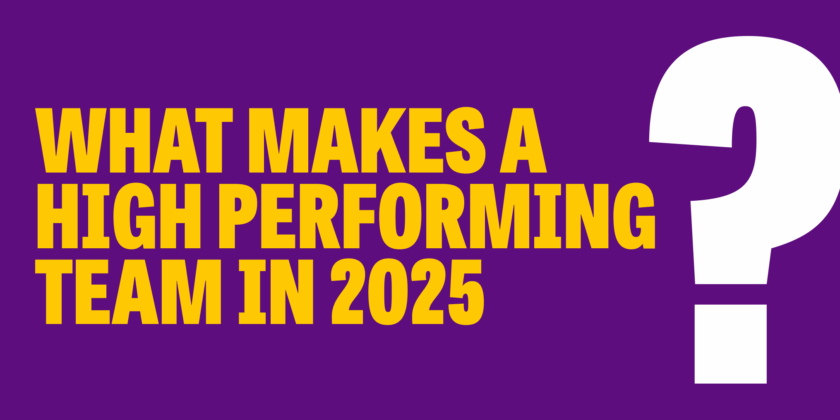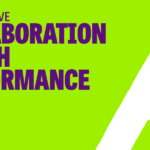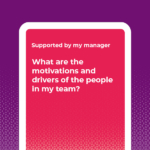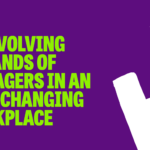It’s 8:59am. Everyone’s piling into the meeting room – half remote, half in person. Someone’s on mute. Someone’s late. Someone’s trying to load up the shared doc. But amidst the chaos, something else is happening.
There’s energy. Focus. A sense of mutual respect. Someone calls out a win from yesterday. Someone else asks for help. Cameras on, mics off mute, real conversations happening. You can feel the difference.
This is what a high-performing team looks and feels like in 2025. It’s not flawless – it’s functional. Human. Adaptive. Safe.
The blueprint for high-performing teams has fundamentally shifted. While past decades focused on hitting targets and meeting deadlines, today’s most successful teams are built on something deeper: shared purpose, psychological safety, and the agility to thrive in uncertainty.
The workplace transformation of recent years – accelerated by remote work, AI integration, and evolving employee expectations – has redefined what it means to perform at the highest level. Teams that simply execute tasks are being outpaced by those that adapt, innovate, and support each other through constant change.
In 2025, only teams rooted in trust, inclusion, continuous learning and crystal-clear direction will sustain excellence. The question isn’t whether your team can deliver results today, but whether they can evolve and excel tomorrow.
The New Core of High-Performance
The foundation has shifted from individual brilliance to collective intelligence. Today’s exceptional teams operate with a unified mission that transcends departmental boundaries and connects daily work to meaningful outcomes. Every team member understands not just what they’re doing, but why it matters.
High trust and psychological safety form the bedrock of this new model. Team members speak openly about challenges, admit mistakes without fear, and offer ideas knowing they’ll be heard with respect. Crucially, they also feel comfortable discussing workload concerns and early signs of burnout before they become critical issues. In 2025’s always-on work environment, teams that normalise conversations about sustainable pace and mental wellbeing prevent burnout before it derails performance. This isn’t soft leadership, it’s a strategic advantage that protects both people and business.
Growth mindset and willingness to learn separate good teams from great ones. In a world where skills become obsolete faster than ever, teams that embrace learning as a core competency stay ahead of disruption rather than react to it.
Diversity in skills, ideas, and backgrounds drives innovation and problem-solving capability. Teams that look, think, and work differently consistently outperform homogeneous groups in creativity, decision-making, and adaptability.
These elements work together to create teams that don’t just perform; they evolve, innovate, and sustain excellence regardless of external pressures.
2025’s Must-Have Traits for High-Performing Teams
Psychological Safety & Trust
Team members speak candidly about failures, ask questions without judgement, and take calculated risks, knowing they’re supported. Leaders model vulnerability by admitting their own mistakes and uncertainties. This creates an environment where innovation flourishes because people aren’t afraid to experiment and potentially fail.
Purpose, Alignment & Shared Goals
Every team member can articulate how their work connects to broader organisational objectives and societal impact. Goals are co-created rather than imposed, ensuring buy-in and ownership. Regular alignment check-ins keep everyone moving in the same direction even as priorities shift.
Strong, Empathetic Leadership
Leaders in high-performing teams act as coaches and facilitators rather than commanders. They demonstrate emotional intelligence, actively listen to team concerns, and adapt their leadership style to individual needs. They prioritise their team’s growth and wellbeing alongside business outcomes.
Open Communication & Collaboration
Information flows freely across all levels and functions. Teams use structured communication protocols that ensure important information reaches everyone who needs it. Collaboration tools are leveraged strategically, not just for convenience but to enhance collective problem-solving.
Diversity, Equity & Inclusion
Teams actively seek diverse perspectives and create inclusive environments where all voices are heard and valued. This goes beyond demographic diversity to include diversity of thought, experience, and working styles. Inclusive practices are embedded in daily operations, not treated as separate initiatives.
Data-Driven Decision Making & Tech Adoption
Teams leverage analytics and AI tools to inform decisions while maintaining human judgement for context and nuance. They’re comfortable with technology but don’t let it replace human connection and creativity. Data guides strategy, but empathy guides execution.
Accountability & Mutual Support
Team members hold themselves and each other accountable to high standards while providing support when challenges arise. Accountability is about commitment to shared success, not blame or punishment. Support is proactive, team members anticipate and address each other’s needs.
Agility, Resilience & Continuous Learning
Teams pivot quickly when circumstances change without losing sight of their core purpose. They view setbacks as learning opportunities and build resilience through preparation and mutual support. Continuous learning is built into regular workflows, not treated as an add-on activity.
Wellbeing & Recognition
Team members’ mental, physical, and emotional wellbeing is prioritised as essential to sustained performance. Recognition is frequent, specific, and aligned with team values. Success is celebrated collectively, and individual contributions are acknowledged meaningfully.
Team Performance in 2025 – What’s Changed?
The shift from static roles to agile, cross-functional work has transformed how teams operate. Traditional hierarchies are giving way to fluid structures where expertise matters more than title, and team members seamlessly move between leader and contributor roles based on project needs and strengths.
Hybrid work and distributed leadership have fundamentally altered team dynamics. High-performing teams in 2025 excel at creating connection and collaboration regardless of physical location. They’ve mastered the art of inclusive virtual meetings, asynchronous decision-making, and maintaining team culture across time zones.
Coaching has evolved from a luxury to a necessity in high-performing teams. Leaders now act as coaches first, helping team members develop skills, navigate challenges, and unlock their potential. This shift from directive management to developmental coaching creates teams that are more resilient, innovative, and capable of self-direction. Regular coaching conversations – both formal and informal – help team members grow continuously rather than waiting for annual reviews.
Tech fluency is no longer optional – it’s essential. Teams that thrive understand how to leverage AI for enhanced productivity, use collaboration platforms strategically, and interpret analytics to guide decisions. However, they balance technological efficiency with human creativity and emotional intelligence.
The most significant change is the move from measuring teams solely on output to evaluating them on adaptability, engagement, innovation, wellbeing, and performance holistically. Success metrics now include team resilience, learning velocity, and ability to navigate uncertainty.
Future-Ready Habits to Build and Sustain High-Performing Teams
Building exceptional teams in 2025 requires intentional practices embedded into regular operations:
Co-create vision and success metrics with your entire team. When everyone participates in defining what success looks like, commitment and ownership naturally follow. Regular vision alignment sessions ensure the team stays connected to purpose even as tactics evolve.
Use regular surveys and feedback tools to pulse-check team health, psychological safety, and engagement levels. Act on the insights gathered – feedback without action erodes trust. Create multiple channels for input, from formal surveys to informal check-ins.
Embed diversity, equity, and inclusion into hiring, development, and daily team practices. This means examining processes for bias, creating equitable growth opportunities, and creating an environment where all team members can contribute their best work.
Invest in learning, coaching, and knowledge sharing as core team activities. Allocate time and resources for skill development, cross-training, and external learning. Create systems for team members to share knowledge and learn from each other’s experiences.
Celebrate team and personal wins regularly and meaningfully. Recognition should be timely, specific, and aligned with team values. Celebrate both results and behaviours that contribute to team culture and long-term success.
LTT’s Approach to High-Performing Teams
At LTT, we understand that building high-performing teams requires more than good intentions. It demands strategic frameworks, practical tools, and ongoing support – we like to think of it as combining art, science and human!
We work with organisations to assess their current team dynamics, identify growth opportunities, and implement tailored strategies that align with their unique culture and goals. Our team performance frameworks help leaders understand the complex interplay between individual strengths, team dynamics, and organisational objectives.
Our consultants bring deep expertise in facilitating the conversations and changes necessary to build psychological safety, establish clear purpose, and create inclusive environments where all team members thrive. We don’t just diagnose challenges, we partner with you to implement sustainable solutions.
Through our people development strategies we help organisations create systems that support continuous learning, effective feedback, and meaningful recognition. Our approach ensures that high performance becomes a sustainable competitive advantage, not a temporary improvement.
FAQs
What makes a high-performing team in 2025?
High-performing teams in 2025 are characterised by shared purpose, psychological safety, adaptability, and trust. They combine diverse perspectives with inclusive practices, leverage technology strategically, and prioritise both results and wellbeing. Unlike teams focused solely on output, they excel at learning, evolving, and sustaining excellence through change.
Why is psychological safety crucial for teams?
Psychological safety enables team members to speak openly, take risks, and learn from mistakes without fear of punishment or ridicule. This creates an environment where innovation flourishes, problems are identified and solved quickly, and team members feel valued and engaged. Research consistently shows that teams with high psychological safety outperform others in creativity, learning, and overall effectiveness.
How does hybrid work influence team performance?
Hybrid work requires teams to excel at both virtual and in-person collaboration. High-performing hybrid teams develop strong communication protocols, use technology strategically to maintain connection, and create inclusive practices that ensure all team members can contribute regardless of location. They’re intentional about building relationships and culture across different work environments.
Ready to transform your team’s performance? Audit your current team dynamics and discover how LTT can help your team thrive in 2025. Our bespoke team performance consultations provide the insights and strategies you need to build a resilient, high-performing team that excels in today’s complex business environment.



